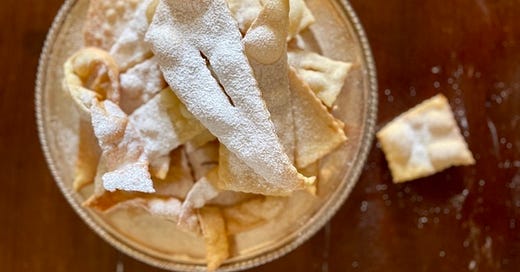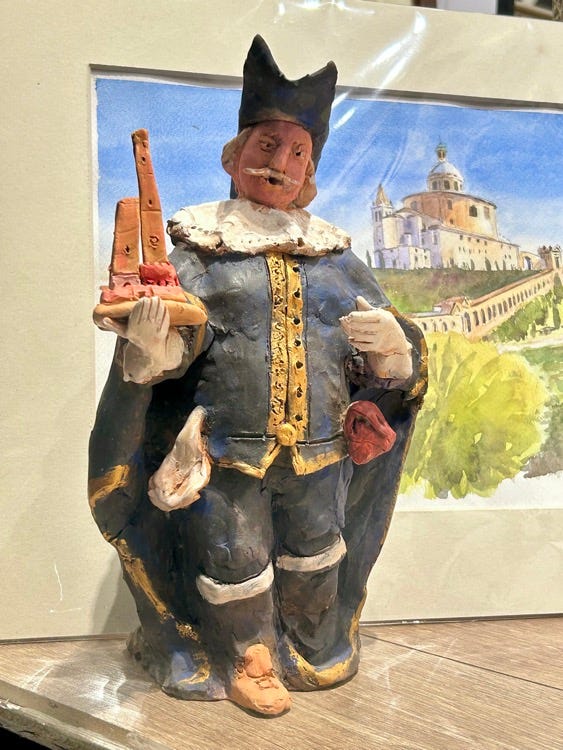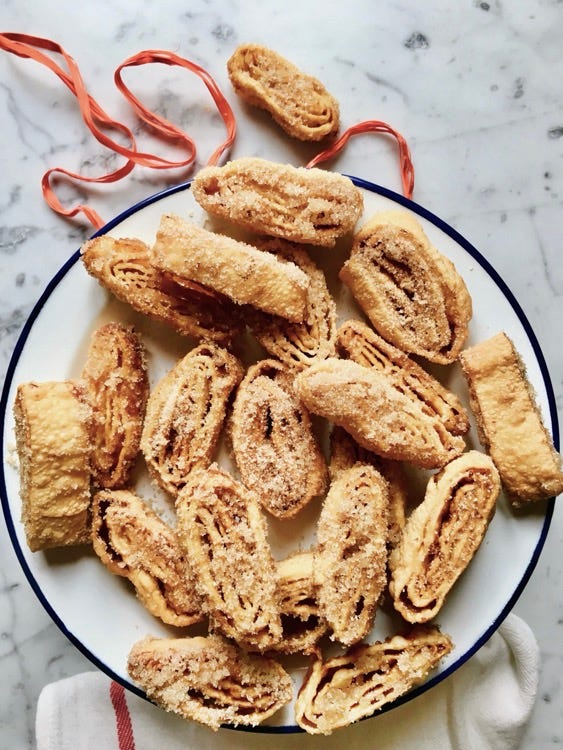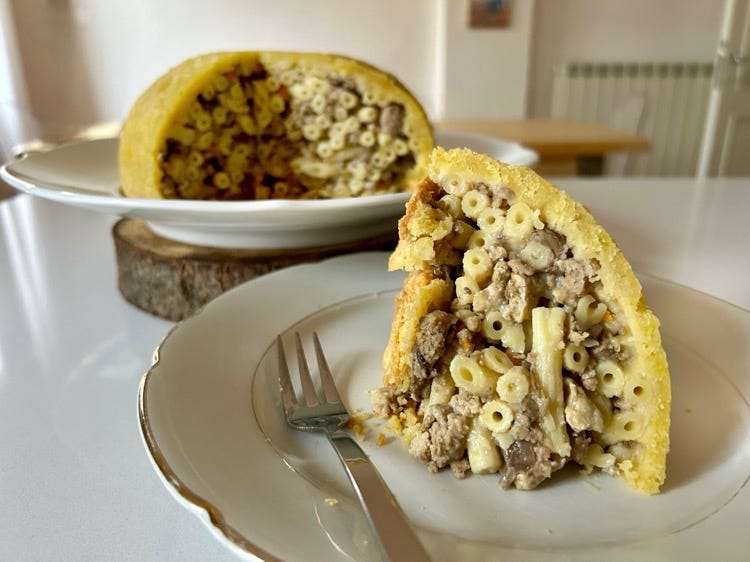Via Emilia: Carnival in and around Bologna
Recipes: sweet tortelloni; sweet tagliatelle and Mardi Gras lasagne
It has been a tiring week.
I'm writing an article for an Italian magazine, about porticoes of Bologna. It has meant a lot of inspections, thinking about what to mention and what to leave to fly away. Writing about this or about that? That is the problem! Luckily, in Bologna, the carnival stores, full of good things to look at and eat, made me smile every now and then during my walks.
Here is my advice about the carnival for people who are not Bolognese.
As the clerk of the Paolo Atti & Figli Bakery told the surprised Neapolitan journalist who interviewed me about the Crescente (the typical focaccia of the city), Carnival in Bologna starts the day after the Befana. I laughed, but it is true. In Bologna, we have a very, very long Carnival season. There are no masks around downtown and no famous parade. We celebrate the season with a lot of fried food.
Almost every Italian city has its own traditions, whether sweets or masks. Among the carnival's most beloved fried treats is frappe, which, in Emilia-Romagna, is the queen of the carnival. Along the Via Emilia, it has many different names. Sfrappole in Bologna, intrigoni in Reggio Emilia, fiocchetti in Romagna. Around Italy you also find them as chiacchiere, crostoli, cenci, sprelle, galani, meraviglie.
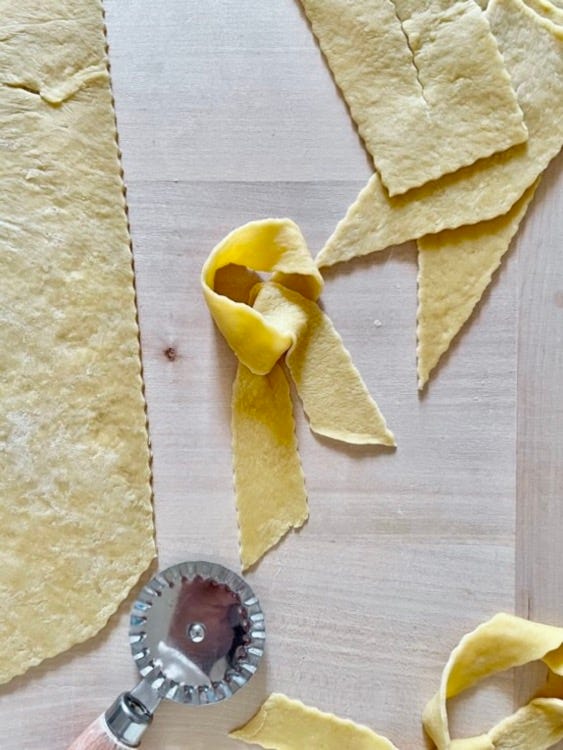

My maternal grandmother's sfrappole was light and crispy (the recipe is on my blog). To this day, I still prefer them to the somewhat thick ones that are crumblier than crispy. After frying them, before dusting with powdered sugar, she would douse them with a few drops of Rosolio liquor.
Today, chiacchiere are almost always rectangular with a cut in the middle. Still, grandma's sfrappole were elegantly knotted in the guise of a bow, just as Italian bakeries offered between the 1950s and 1980s.
If you enjoyed my newsletter, please click on the ❤️ heart, leave a comment, or share it. GRAZIE!
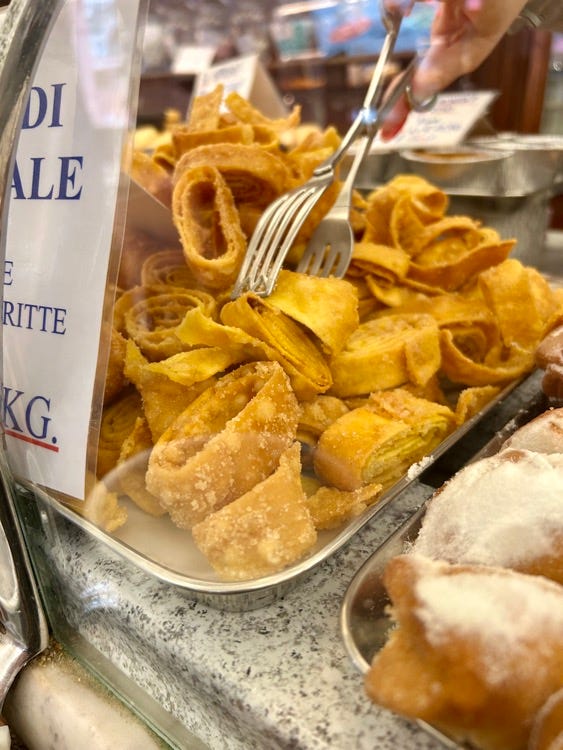
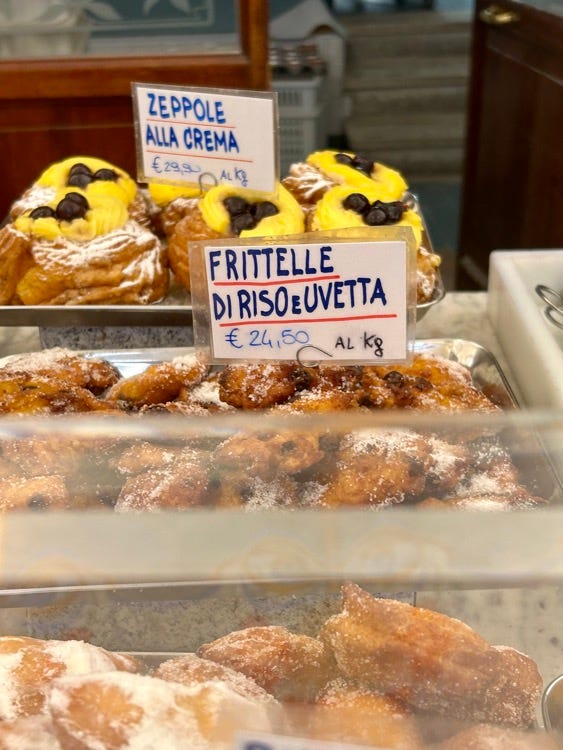
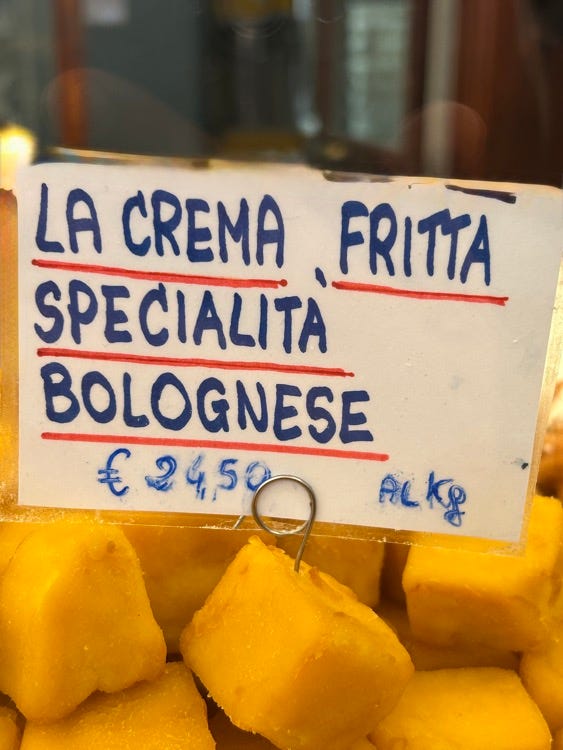
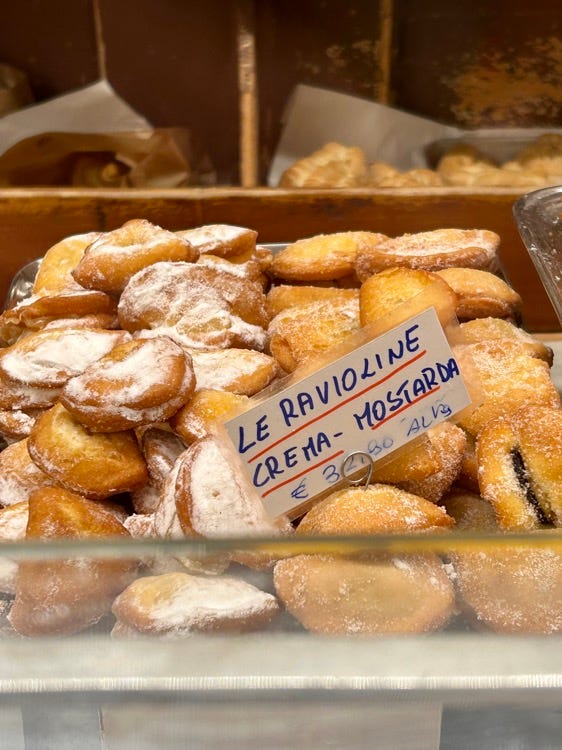
Typical carnival recipes from Bologna
Sweet tagliatelle. Along with sfrappole, this is one of my favorites of the season. It is a traditional sfoglia (eggs and flour) enriched with sugar and lemon zest. The nests of tagliatelle, once fried, are crispy.
Custard. Fried, of course.
Rice fritters and rice and raisin fritters. If you ask my mom and mother-in-law, they will tell you their hearts beat for them. And for fried custard.
Ravioline filled with pastry cream. The name and shape recall pasta ravioli. Ravioline are miniature versions of raviole (femenine) cookies. These are the typical peasant cookies of Bologna, usually stuffed with sweet mostarda Bolognese. At Carnival and Easter, ravioline are stuffed with custard and, only at carnival, fried.
As for raviole, tortelloni name and shape recall a fresh pasta. These are sweet, filled with custard and fried. Unlike sfrappole and tagliatelle, ravioline and tortelloni have a shortcrust pastry dough. Tortelloni can also be shaped like a tortello (rectangular).
Fried cream and fried semolina are not strictly carnival sweets. They are usually cubes of about 2 cm, dipped in egg and flour (or breadcrumbs), fried, and sprinkled with granulated sugar. Both are part of Bologna's sweet tradition, and of the dish known as Fritto Misto or Gran fritto Bolognese. It brings together sweet and savory ingredients: meat, vegetables, fruit, and custard or semolino (all fried).
Topini (little mice) is a homemade preparation, sometimes empty and sometimes stuffed. They can resemble zeppole (with a tail).
Il dottor Balanzone
The mask of Bologna is Dottor Balanzone.
He is a sturdy fellow and a great eater and represents the jurist and the doctor, in an ironic key. The name comes from the archaic Italian balanza (scales), an allegory of justice.
In addition to him, among the minor masks, we find Fagiolino, a witty and enterprising servant who originated in the world of puppets, a form of entertainment that has an ancient tradition in Bologna and is still popular today. Sganapino is the brat who usually ridicules what Fagiolino does. Finally, there is Sandrone, the mask of Modena, a poor man always looking for stratagems for eating.
The Spirit of Carnival
Today is carnival every day (Mrs. Irene, 80)
The celebration is less felt than it used to be when the carnival was an opportunity to overturn the daily rigor. Once a year, the rules and restraints of a life usually governed by strict social behavior and gastronomic sobriety dropped, only to be reinstated with the start of Lent. The strongest urge to enjoy the freedoms of carnival came from the strict observance of religious norms at the table and the near-fasting imposed during the 40 days leading up to Easter.
In the post-World War II era, the religious dictates lost their force, and Italian eating habits began to change. Today, the restrictive character of Lent concerns only a few people. Most don't observe any rules arising from religious practices.
That has changed the spirit of carnival.
Of course, fried sweets and some historic festivals survive.
Among the most famous are Venice, Viareggio, and Ivrea. The first is a carnival famous for its masks, the second for its parade of floats, and the third for the battle of oranges (in the 19th century, beans were used).
The most significant carnival in Emilia-Romagna is that of Cento (Ferrara). It is a festival dating back to the 17th century, and Guercino immortalized it in a painting. Guercino was a famous Italian painter; today, his masterpieces are valued $7 to $10 millions. It is the only Italian carnival that is twinned with the famous Rio de Janeiro Carnival, and its parade is memorable (program).
An ancient but little-known mountain carnival
If macaroni and polenta are interesting topics, I must tell you about that carnival.
The one celebrated in Borgo Tossignano is not famous even though it is recognized as a historic carnival. You won't find impressive parades of floats or people dressed in fancy masks in this tiny village (about 3 thousand inhabitants) in the Romagna-Tuscan Apennines, where my paternal family comes from. The village is part of Bologna's area but for culture, dialect, traditions, and food is Romagnolo.
Here, the only crush is usually in front of the stalls that distribute free macaroni al ragù in Borgo and polenta (with ragù) in Tossignano.
The Macaroni Carnival has been celebrated for 125 years, and the Polenta Carnival for more than 400. This mountain carnival is simple, authentic, no-frills.
Borgo Tossignano is divided in two parts. The hamlet of Tossignano is perched on an Apennine spur jutting out over the Santerno valley, which looks down on Borgo from above (so to speak). There has always been a rivalry between the lower and upper parts. For this reason, for the past few years, the festival has begun with an exchange of commemorative dishes between the maccheronari of Borgo and the polentari of Tossignano.
This year, I interviewed those in charge of the two festivals about Tossignano's and Borgo's ragù. The polentari responded elusively; that is, they did not respond. The maccheronari were more forthcoming: no soffritto, mixed meats, lots of tomato sauce, very long cooking time.
That is Italy. Rivalries and secret recipes.
Spring Fairy Queen.
A sad story
In everyone's life, there are episodes to forget.
One of mine recalls a carnival party many years ago. I was a child with a lot of imagination and a fatal attraction to romantic aspects and wrong clothes.
It was a dress for the Spring Fairy Queen. A huge pink meringue wholly covered in tulle and adorned with branches and flowers. To complete the look, a fancy hat, also pink. The dress was broad and heavy to wear.
When it was time to go out, my mother said to wear comfortable shoes. I was desperate. It was an affront to the elegance that the dress required. Still, at that point, I think the tulle was already suffocating my brain.
The final blow came from the weather. It was a windy day. So I had to keep one hand on the hat to avoid losing it and one on the dress to lift it and not trip. Moreover, this showcased the Achilles' heel of my vanity: the awful comfortable shoes.
I'm sure that neither before nor after has there ever been a Spring Fairy Queen with such a strong and fatal pyromania urge.
Carnival recipes
Baked sweet tortelloni or fried sweet tagliatelle?
I'm also sharing two savory recipes typical of the Carnival period. The first is Ferrara's macaroni pie, a Renaissance-era recipe widely spread in many regions of Italy, even under other names.
In the Ferrara version, the pasta topped with white meat sauce (and truffle) is wrapped in a crispy shell of sweet shortcrust pastry. The second savory recipe is for Martedì grasso lasagne, typical of Romagna's peasant cuisine. The main ingredient is a local cheese called Fossa cheese (I mentioned it in this newsletter). Just in case, I have indicated in the recipe how to substitute it.
Sweet tortelloni
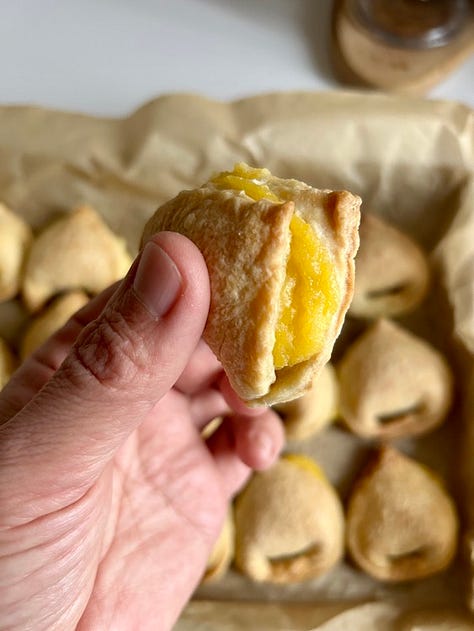
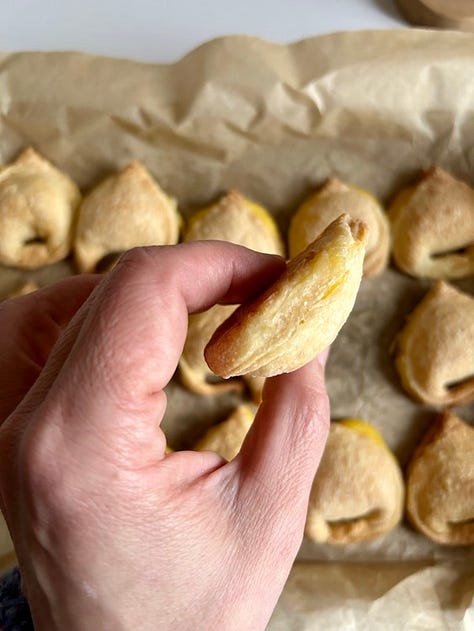
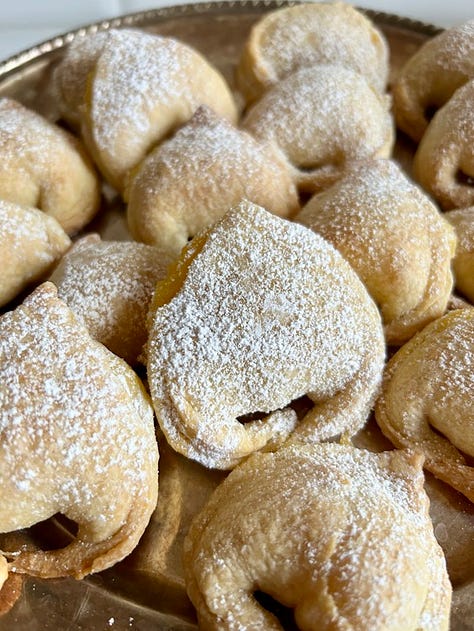
This year, for the first time, I decided to try baking the family recipe for sweet tortelloni, and it worked. Of course, fried and baked are two different things. However, it can be a viable option for those who do not want or cannot eat fried food. Try to seal the edges as well as you can, and if any tortelloni open during baking, which is possible, don't worry; the custard doesn’t run away (see photo above recipe). Because I need a firmer custard for this recipe, I use egg yolks and whites.
for about 20 tortelloni
Ingredients
Shortcrust pastry
200 g of 00 or all-purpose flour
1 g of fine salt
50 g of granulated sugar
1 egg, shelled
100 g of cold butter, cut into small pieces
Custard
60 g of granulated sugar
2 small, shelled whole eggs (yolks and whites)
50 g of sifted 00 flour
300 ml milk
1 teaspoon grated lemon rind
icing sugar for decoration
Read the full recipe on the blog.
Sweet tagliatelle
4-6 serves
Ingredients
Filling
100 g of brown or caster sugar
1 organic lemon grated zest
Pasta dough
200 g of 00 flour
2 medium eggs
1 pinch of salt
30 g of rum or grape or marsala wine
1 l of seed oil for frying
Method
Filling
Grate the zest of an organic lemon into the sugar bowl and mix using your fingertips. This will help the sugar absorb the lemon's essential oils. Set aside.
Pasta dough
Place flour on a wooden surface.
Make a well in the center of the flour, and add the eggs, salt, and rum.
Use a fork to break up the eggs and gradually bring the flour toward the center.
Mix until large crumbs form. From this point on, work the dough with your hands for about 10 minutes or until the mixture is smooth and soft but not sticky.
Form a ball and let the dough rest, even outside the refrigerator, wrapped in plastic for 30 minutes.
After resting, roll out a thin sheet with the pasta machine or on the cutting board.
Sweet tagliatelle
Spread the sugar evenly over the surface of the sheet, roll it, and cut the tagliatelle 1 cm wide.
Bring the oil to the right temperature and fry a few pieces at a time.
When the dipped part starts to brown, turn it over. The sweet tagliatelle are ready as soon as they turn golden brown.
Place them on kitchen paper to absorb the excess oil.
Dip them in caster sugar.
Let cool before serving.
They will keep fragrant for a few days. Store out of the refrigerator.
Macaroni pie from Ferrara: the recipe
I think it is a oh-my-God kind of recipe. Give a look

